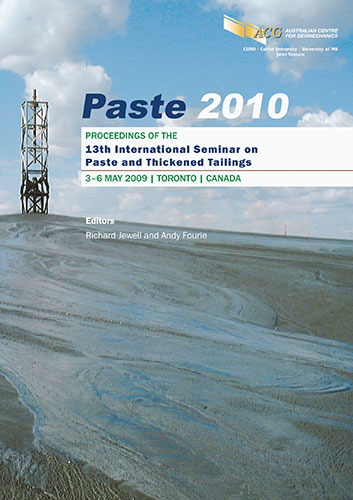Tailings philosophies — to segregate or not to segregate

|
Authors: Wells, PS |
DOI https://doi.org/10.36487/ACG_rep/1063_39_Wells
Cite As:
Wells, PS 2010, 'Tailings philosophies — to segregate or not to segregate', in R Jewell & AB Fourie (eds), Paste 2010: Proceedings of the Thirteenth International Seminar on Paste and Thickened Tailings, Australian Centre for Geomechanics, Perth, pp. 451-458, https://doi.org/10.36487/ACG_rep/1063_39_Wells
Abstract:
Facilities in the oil sands of north-eastern Alberta have developed and operated several generations of technologies for the treatment of tailings resulting from bitumen extraction processes. These processes produce tailings streams that undergo segregation when discharged into water filled ponds. Coarse sand settles to the pond bottom as long beaches, while a percentage of the silts and clays remain suspended within the water column and are viewed as a major contributor to the oil sand challenges of water loss and storage volume increases. Traditional methods of dealing with these challenges have involved mainly recombining all the original solids (sands, silts and clays) into a non-segregating mixture. These methods assume that mixing the ‘good’ coarse material with the partially settled ‘bad’ suspended silts and clays can result in a well behaved, reclaimable deposit. This may not be the case, and it can be suggested that the pursuit of this goal may have created unrealistic objectives for tailings treatment, and served to slow development. An alternative treatment philosophy is to identify the materials which are at the root of the existing tailings challenges and develop systems to isolate and treat those materials. Several technologies exist for this, and direct comparisons between these two philosophies involving the treatment material balances, process water balance, and material handling requirements can be made. Such comparisons have identified opportunities for improvements in the technology development focus by the various research and operational organisations and are beginning to produce alternative technologies that are more robust and effective.
References:
Donahue, R., Jeeravipoolvarn, S., Scott, D. and Ozum, B. (2008) Properties of Non-segregating Tailings Produced from
the Aurora Oil Sands Mine Tailings, in Proceedings First International Oil Sands Tailings Conference,
OSTRF/CONRAD, Edmonton, AB, pp. 143–152.
Fine Tailings Fundamentals Consortium (1995) Vol I. Fundamental Properties of Fine Tails in: Advanced in Oil Sands
Tailings Research, Alberta Department of Energy, Oil Sands and Research Division, pp. 45–54.
Sobkowicz, J. and Morgenstern, N.R. (2009) A geotechnical perspective on oil sands tailings, in Proceedings Tailings
and Mine Waste ’09, U of A Geotechnical Centre, Edmonton, AB, pp. xvii–xli.
Wells, P.S. (2004) Advances in CT Deposition at Suncor Energy, Oilsands, CONRAD Tailings Seminar, Edmonton,
Powerpoint presentation.
Wells, P.S. and Riley, D.A. (2007) MFT Drying – Case Study in the Use of Rheological Modification and Dewatering
of Fine Tailings Through Thin Lift Deposition in the Oil Sands of Alberta, in Proceedings Tenth International
Seminar on Paste and Thickened Tailings, A.B. Fourie and R.J. Jewell (eds), Australian Centre for
Geomechanics, Perth, Australia, pp. 271–284.
© Copyright 2025, Australian Centre for Geomechanics (ACG), The University of Western Australia. All rights reserved.
View copyright/legal information
Please direct any queries or error reports to repository-acg@uwa.edu.au
View copyright/legal information
Please direct any queries or error reports to repository-acg@uwa.edu.au